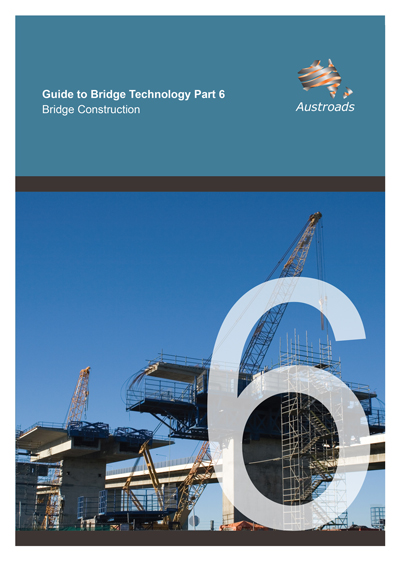Bridges

- Publication no: AGBT06-18
- ISBN: 978-1-925671-01-8
- Published: 19 February 2018
- Edition: 2
- PDF (free) Download
- View online View guide
To ensure that bridges are properly constructed in accordance with the design drawings and specifications, engineers need to be well-informed on all aspects of their design and construction, including awareness of the problems that may arise and the levels of the various risks associated with their realisation. They need to know the important quality, safety, environmental and other issues relating to each activity before the activity is undertaken.\n\n
Guide to Bridge Technology Part 6 provides guidance to the bridge owner's representative on site and focuses on bridge technology, high-risk construction processes, e.g. piling, pre-stressing, and the relevant technical surveillance requirements during the construction phase. Bridge geometry, the management of existing road traffic and temporary works are also discussed. This Part also discusses activities related to the processes of bridge demolition and removal, as well as after bridge completion and handover.
Edition 2.0 provides updated details and information, and removes overlapping information. Major changes include:
- Section 2: Management Context | In Section 2.4 added a note for collecting and managing construction documentation.
- Section 11: Bank and Abutment Protection | In Section 11.3 added a requirement for using geofabric in association with gabion and rock mattresses and a requirement for adequate compaction of the embankment material in the vicinity of the structure, to prevent the loss of backfill material and scour.
- Section 13: Concrete Construction | Added Section 13.5 Match-cast, which discusses this precast construction technique.
- Section 14: Concrete Defects and Rectification | In Section 14.3.7 added a requirement for sealing cracks for bridges located in aggressive environments.
- Section 16: Steel Construction | In Section 16.4.1 Fabrication of Steelwork added a commentary on the requirements of AS/NZS 5131 for fabrication and erection of steelwork. In Section 16.5.7 Electrodes added a requirement for the material test certificate for welding consumables. In Section 16.6.2 High-strength Bolting added requirements on tightening of bolts, bolt traceability and torque control methods.
- Section 17: Timber Construction | In Section 17.7.1 added a note on the green timber effect if moving timber between different climate zones. In Section 17.14 added alternative materials for replacement of deck components. In Section 17.16.4 added a note on the effects of excessive shrinkage and creep on laminates. In Section 17.17 added a note on the use of timber piles in the past.
- Section 19: Bearings, Deck Joints and Deck Drainage | In Section 19.3.6 added a requirement on the correct installation of the template for the strip seal joints.
- Section 21: Ancillary Components | In Section 21.2 Support Structures added requirements for installation of base plates and splice joints.
-
-
-
-
-
-
-
-
-
-
- 13.2.1 Falsework and Formwork (Installation)
- 13.2.2 Construction Joints
- 13.2.3 Fixtures and Reinforcement
- 13.2.4 Delivery of Concrete
- 13.2.5 Transport and Handling of Concrete
- 13.2.6 Placing of Concrete
- 13.2.7 Compaction
- 13.2.8 Screeding and Floating
- 13.2.9 Trowelling and Texturing
- 13.2.10 Curing
- 13.2.11 Formwork and Falsework (Removal)
- 13.2.12 Formed Surface Finishes and Restoration
- 13.2.13 Sampling and Testing
-
-
- 14.3.1 Low Concrete Strength
- 14.3.2 Insufficient Concrete Cover to Projecting Reinforcement at a Construction Joint
- 14.3.3 Damaged Reinforcement Projecting from a Construction Joint
- 14.3.4 Non-conforming Finish – Unformed Surfaces
- 14.3.5 Non-conforming Finish – Formed Surfaces
- 14.3.6 Voids in Concrete
- 14.3.7 Excessive Cracking
-
-
-
-
-
- 19.2.1 Bearing Position, Level, Longitudinal Flatness, Transverse Slope
- 19.2.2 Fixed and Expansion Bearings
- 19.2.3 Strip and Pad Bearings
- 19.2.4 Laminated Elastomeric Bearings
- 19.2.5 Pot Bearings
- 19.2.6 Mortar Pads
- 19.2.7 Tapered Steel Plates
- 19.2.8 Other Types of Bearings
- 19.2.9 Loading of Bearings
- 19.2.10 Construction Stability
-
- 19.3.1 General
- 19.3.2 Fixed Joints
- 19.3.3 Expansion Joints – General
- 19.3.4 Compression Joint Seals – Supply and Installation
- 19.3.5 Cold-applied Elastomeric Joint Sealants
- 19.3.6 Elastomeric Strip Seal Expansion Joint
- 19.3.7 Finger Plate Deck Joints
- 19.3.8 Modular Bridge Expansion Joints (MBEJ)
- 19.3.9 Construction Issues for All Deck Joints
-
-
-
-
Tables
-
Figures
